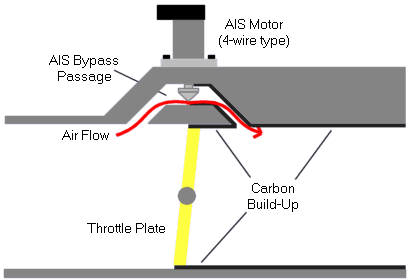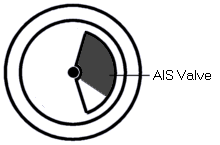
[ Idles Too Low Or Stalls | Idles Too high | Minimum Air Adjustment ]
The engine will not properly idle, or will stall. These symptoms may or may not be associated with one or more fault codes.
As you can see, there are many things that can be the cause of an idling problem. This section will attempt to narrow it down, but expect some trial-and-error. Skip to the section that applies to you: Engine Idle Is Too Low Or Stalls or Engine Idle Is Too High. They are in a general most-likely-to-occur order.
Probably the most common problem that causes idle problems in multiport fuel injected engines is a carboned-up throttle body. The symptoms include stalling when coming to a stop, or very low idle after starting, or stalling if the throttle is "blipped" (opened and closed quickly).
When the engine is shut off, crankcase vapors enter through the PCV system and work their way into the intake system towards the air box. The vapors carry with them oil and soot which comes to rest on the ducts and throttle plate. When the engine is started again, the incoming air carries this oil and soot back to the throttle body and are deposited just behind the throttle plate because of the sudden drop in air pressure behind the plate. This build-up eventually blocks off the gap between the throttle plate and throttle body bore, causing lees air flow while the throttle plate is closed. Over time, the computer compensates by opening the AIS valve further to bypass more air. The problem is that it gets harder for the computer to control the idle, especially when coming to a stop or when the throttle is "blipped". This build-up also occurs in the AIS passage as well and eventually the AIS cannot bypass enough air to keep the engine idling.

To fix this problem, remove and disassemble the throttle body. Using a solvent, carb-cleaner, or "Brakcleen", clean out the throttle body bore, the throttle plate (especially the edges), and the AIS bypass passage. A small toothbrush or pipe brush can be helpful. Once the throttle body is cleaned, the air will be able to pass by the throttle plate as it should. This may result in a high idle until the computer compensates by closing the AIS.

You may find that the idle does not seem to eventually drop to 800 RPM. If this is the case, see the Minimum Air Adjustment section. It should be noted that throttle body-injected and carbureted engines generally do not have this problem because the throttle plate is constantly cleaned by fuel.
This is probably the second-most common failure. The symptoms for this are usually stalling when coming to a stop. This condition is often associated with a fault code 15, but the sensor can become intermittent and cause idle problems without triggering the fault code. The computer uses the speed/distance sensor to determine the vehicle's speed. As you decelerate, the computer closes the AIS bypass. As the vehicle comes to a stop, it opens it again to maintain the idle speed. This is especially important for vehicles equipped with an automatic transmission because the transmission loads the engine while in gear. Without valid data from the sensor, the ECU does not know when the vehicle is stopping and often cannot open the AIS bypass fast enough to keep the engine from stalling. The only way to solve the problem is to replace the sensor. Be sure to check the wiring first, though. Occasionally, the connector on the sensor itself gets oily and comes loose.
This is a less common problem. It is almost always associated with a fault code 13 or fault code 14. The resulting limp-in mode causes a poor intake mixture, causing erratic idle. See the fault code links for more information.
This is a less common problem. It is often associated with a fault code 24. The computer is not able to determine if the throttle is closed or not. This problem is usually accompanied by poor/erratic running engine with little or no power. See the fault code links for more information.
The first thing to check for here is a vacuum leak. Sometimes it can be difficult to track down broken hoses, but it takes a large vacuum leak to cause a high idle. Check the rubber hoses that connect directly to the intake manifold and throttle body. These are the most likely to fail. The best way to track down a mysterious leak is to remove a vacuum line and block its source with your finger. If the idle speed drops significantly below where it was before you removed the line, then you may have found your problem. Also look at the gaskets and air ducts between the throttle body and the intake manifold. It is unlikely, but you could have a leaking intake manifold gasket as well.
The next thing to check is the throttle stop. See the Minimum Air Adjustment section for more details on how to check and adjust this. Also check that the throttle is being completely released against the throttle stop by the throttle cable. If the cable is holding it open, make sure that the accelerator pedal is not caught or binding on anything. Also check that the throttle return springs are in tact. There are usually 2 torsion-type coil springs around the base of the throttle arm and 2 pull-type springs between the throttle arm and the throttle body.
The last thing to check is the AIS motor. Remove the two Torx screws holding the AIS unit and pull it out.
 If you have a 1987 or earlier Turbo I engine, then look in the end of the motor to see if it is completely shut (see diagram on the right). If it is not, then it may not be working. Reconnect the cable to the AIS motor and have someone turn the ignition on. Watch the valve opening for movement. The valve should close, and maybe reopen. If there is no movement, then you may have a bad or seized AIS motor, or a wiring problem. These motors have a tendency to corrode inside and seize up. You can either try to replace it, or take it apart. There are a lot of little gears and parts inside, so proceed at your own risk. Take it apart carefully and be sure to reassemble it the same way. Pay special attention to the orientation of the rotating valve. Clean up all the parts and take the motor apart. Once the motor is free of corrosion, lubricate the bushings with some engine oil. Do not use any silicon-based lubricants. Reassembling the motor and unit with some RTV will help keep moisture out in the future.
If you have a 1987 or earlier Turbo I engine, then look in the end of the motor to see if it is completely shut (see diagram on the right). If it is not, then it may not be working. Reconnect the cable to the AIS motor and have someone turn the ignition on. Watch the valve opening for movement. The valve should close, and maybe reopen. If there is no movement, then you may have a bad or seized AIS motor, or a wiring problem. These motors have a tendency to corrode inside and seize up. You can either try to replace it, or take it apart. There are a lot of little gears and parts inside, so proceed at your own risk. Take it apart carefully and be sure to reassemble it the same way. Pay special attention to the orientation of the rotating valve. Clean up all the parts and take the motor apart. Once the motor is free of corrosion, lubricate the bushings with some engine oil. Do not use any silicon-based lubricants. Reassembling the motor and unit with some RTV will help keep moisture out in the future.
If you have a 1988 or later Turbo I, any Turbo II, or any TBI engine, then you have the pintle-type AIS motor. Remove the AIS unit and rotate the pintle clockwise to screw it in. If it spins easily, then you can try to clean the pintle and shaft with solvent or carb-cleaner. Reconnect the cable to the AIS motor and have someone turn the ignition on. Watch the valve for movement. The valve should spin out, and maybe back in again. If there is no movement, then you may have a bad or seized AIS motor, or a wiring problem. there is little that can be done with these motors besides replacing them.
This adjustment is to set the amount of air that will pass through the throttle plate during idle. It is specified in RPM. It is important that you clean out the throttle body BEFORE performing this adjustment.
In order to make this adjustment, the AIS bypass passage needs to be shut off. The easiest way to do this is with a diagnostic scan tool. Most of them will allow you to instruct the computer to close the AIS valve using a test mode. If you do not have a scan tool, you can use this method (special thanks to Steve Calder for the vacuum leak idea):
You now have the throttle body configured for minimum air. If the engine stalls with the AIS shut, you will have to hold the throttle open slightly while the engine is started and running. Adjust the throttle stop screw to change the minimum air adjustment. If you have an external tachometer, connect it to the negative side of the ignition coil. Otherwise use the tachometer on your vehicle (if you have one). Use the stop screw to adjust the idle so that it is between 500 and 700 RPM.
When finished, shut the engine off, disconnect any tools, and reconnect the AIS motor connector if you removed it. When the engine is restarted, you may find that it takes a while for the engine idle to settle. This is just the computer "re-learning" to control the AIS motor. When the engine has reached operating temperature, it should idle around 800 RPM with the A/C off.
| Return to MiniMopar Resources |
Updated 11/07/2003.
Copyright © 1996-2003 Russ W. Knize.